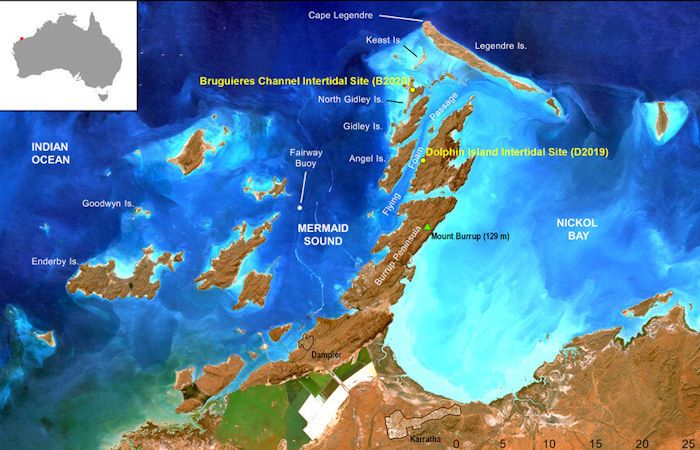Jan Bartek – AncientPages.com – A new study from The University of Western Australia has challenged earlier claims that Aboriginal stone artifacts discovered off the Pilbara coast in Western Australia represent Australia’s first undisturbed underwater archaeological site.
The original findings were made in a study published in 2020 in PLOS ONE, by a team of archaeologists and scientists from Flinders University, UWA, James Cook University, ARA (Airborne Research Australia) and the University of York.

Map of the Dampier Archipelago (Murujuga) showing locations of areas mentioned in the text. (Contains modified Copernicus Sentinel data [2020] processed by Sentinel Hub). Credit: Geoarchaeology (2022). DOI: 10.1002/gea.21917
The team partnered with the Murujuga Aboriginal Corporation to locate and investigate stone scatters at two sites in the Dampier Archipelago.
The “underwater” sites at Cape Bruguieres included hundreds of stone tools found in an area that was dry land many thousands of years ago.
Co-author of the new paper, published in Geoarchaeology, geoarchaeologist Dr. Ingrid Ward from UWA’s School of Social Sciences, said it questioned two key claims made in the original paper—that the artifacts were “permanently submerged” and that they were “in situ” and had not been moved since their original deposition.
“In fact, the artifacts occur in a channel ponded well above the lowest tide, so are not permanently submerged,” Dr. Ward said.
“Further, past and present oceanographic and sediment transport processes indicate that the lithic artifact scatters have almost certainly been moved by waves and currents away from where they were first discarded.”
The new study was carried out in collaboration with UWA’s Dr. Piers Larcombe, Dr. Peter Ross of Flinders University and Dr. Chris Fandry of RPS Energy.
The multidisciplinary team examined the ᴀssumptions and claims made in the original paper, concluding that the analysis had been insufficient to justify its findings.
“It remains untested how old the artifacts are—they could be 200 years old, 2,000 years old or 20,000 years old—it is completely unknown at this stage,” Dr. Ward said.
Despite this, she said we could still learn a lot from reworked sites.
“For all archaeological sites, the scientific narrative depends on defensible interpretation, which means understanding the processes that have formed the sites we find today,” she said.
See also: More Archaeology News
“Science progresses through repeated cycles of research, publication, challenge and correction, and papers that challenge ideas are a normal part of healthy science. Archaeological research of indigenous coastal and marine sites in Australia is still at an early stage.”
The study was published in Geoarchaeology
Written by Jan Bartek – AncientPages.com Staff Writer





